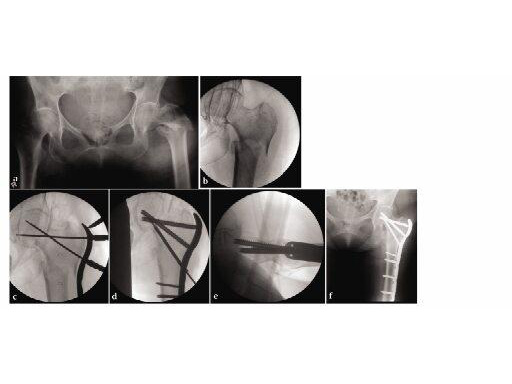
LCP Proximal Femur 4.5
The LCP Proximal Femur 4.5 is part of the Locking Periarticular Plating System, which merges locking head screw (LHS) technology with conventional plating techniques. It is indicated for pertrochanteric fractures, subtrochanteric fractures, instable intertrochanteric fractures, and intertrochanteric fractures with reverse obliques, as well as malunions and nonunions of these fracture types. The LCP Proximal Femur 4.5 is a stainless steel plate with a limited contact profile. The proximal portion of the plate is anatomically contoured to approximate the lateral profile of the proximal femur. Therefore, it comes in a right and left version. The two proximal screw holes accept 7.3 mm cannulated locking and 7.3 mm cannulated conical screws. The third locking hole accepts a 5.0 mm cannulated LHS and is angled to converge at the tip of the proximal 7.3 mm screw and is intended to resist varus deformity forces. The remaining screw holes are locking compression plate (LCP) holes which combine a dynamic compression unit (DCU) hole with a locking hole. This provides the surgeon with the flexibility to gain axial compression and angular stability throughout the length of the plate. Because of the proximal screw configuration, the plate can be compressed with the articulated tension device to create a load sharing construct. This is important and should be the aim whenever possible. This plate can be secured to osteopenic bone, or to bone where there is a cortical defect. The LCP Proximal Femur 4.5 uses existing screws and instrumentation. The stainless steel screws necessary for implantation are: 7.3 mm cannulated conical, 7.3 mm cannulated locking head, 5.0 mm cannulated conical, 5.0 mm cannulated locking head, 5.0 mm and 4.0 mm StarDrive locking head screws, and 4.5 mm cortex screws.
78-year-old osteoporotic female with a left subtrochanteric femur fracture. The proximal femur has a frontal plane fracture in it. Advantages include excellent purchase of the osteoporotic proximal segement, avoidance of abductor devitaliation, and reestablishment of the normal neck-shaft angle.
Hazards and labeling
Due to varying countries’ legal and regulatory approval requirements, consult the appropriate local product labeling for approved intended use of the products described on this website. All devices on this website are approved by the AO Technical Commission. For logistical reasons, these devices may not be available in all countries worldwide at the date of publication.
Legal restrictions
This work was produced by AO Foundation, Switzerland. All rights reserved by AO Foundation. This publication, including all parts thereof, is legally protected by copyright.
Any use, exploitation or commercialization outside the narrow limits set forth by copyright legislation and the restrictions on use laid out below, without the publisher‘s consent, is illegal and liable to prosecution. This applies in particular to photostat reproduction, copying, scanning or duplication of any kind, translation, preparation of microfilms, electronic data processing, and storage such as making this publication available on Intranet or Internet.
Some of the products, names, instruments, treatments, logos, designs, etc referred to in this publication are also protected by patents, trademarks or by other intellectual property protection laws (eg, “AO” and the AO logo are subject to trademark applications/registrations) even though specific reference to this fact is not always made in the text. Therefore, the appearance of a name, instrument, etc without designation as proprietary is not to be construed as a representation by the publisher that it is in the public domain.
Restrictions on use: The rightful owner of an authorized copy of this work may use it for educational and research purposes only. Single images or illustrations may be copied for research or educational purposes only. The images or illustrations may not be altered in any way and need to carry the following statement of origin “Copyright by AO Foundation, Switzerland”.
Check www.aofoundation.org/disclaimer for more information.
If you have any comments or questions on the articles or the new devices, please do not hesitate to contact us.
“approved by AO Technical Commission” and “approved by AO Foundation”
The brands and labels “approved by AO Technical Commission” and “approved by AO Foundation”, particularly "AO" and the AO logo, are AO Foundation's intellectual property and subject to trademark applications and registrations, respectively. The use of these brands and labels is regulated by licensing agreements between AO Foundation and the producers of innovation products obliged to use such labels to declare the products as AO Technical Commission or AO Foundation approved solutions. Any unauthorized or inadequate use of these trademarks may be subject to legal action.
AO ITC Innovations Magazine
Find all issues of the AO ITC Innovations Magazine for download here.
Innovation Awards
Recognizing outstanding achievements in development and fostering excellence in surgical innovation.






